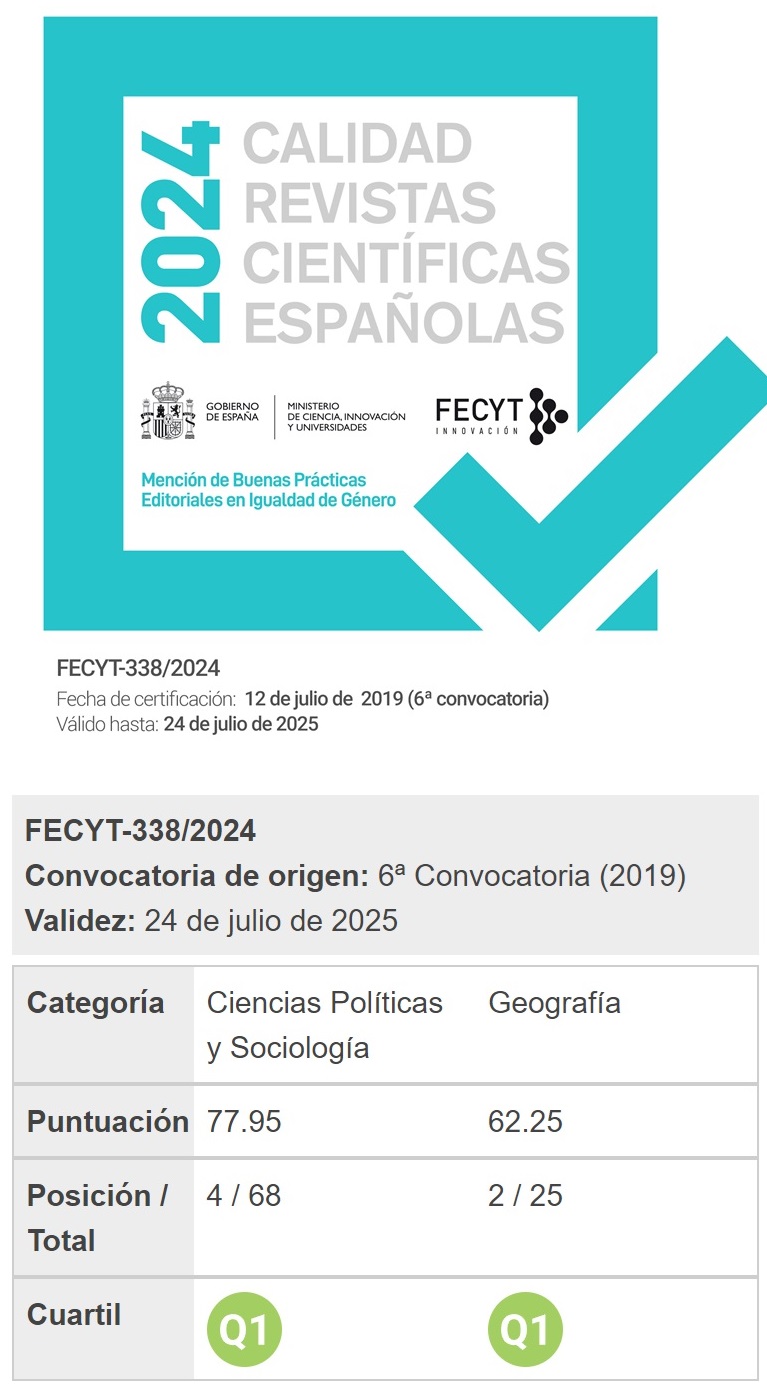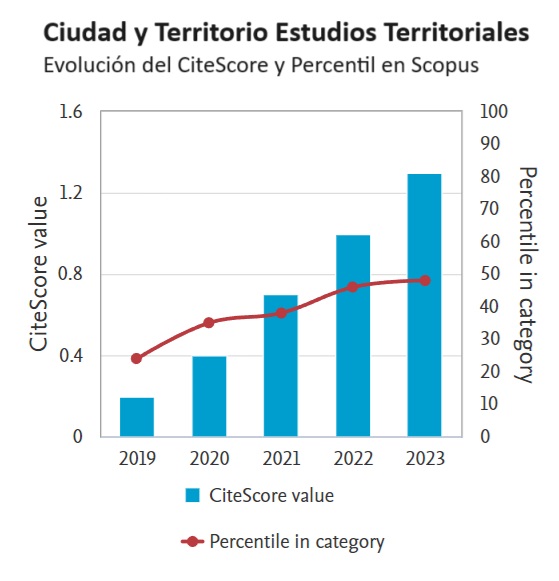La ciudad compartida: el patrimonio cultural como herramienta para la re-creación del relato urbano
DOI:
https://doi.org/10.37230/CyTET.2022.213.4Palabras clave:
Ciudad, Patrimonio cultural, Regeneración urbana, Turismo de masas, Era digital, Narrativa urbanaResumen
En el mundo digital y tecnológico actual, la regeneración urbana podría haber dejado de ser un proceso físico y arquitectónico para pasar a ser, simplemente, una superficial puesta en escena de nuevas y más atractivas imágenes de la ciudad que hagan de la misma un destino deseado. Sin embargo, la representación requiere de un relato que la contextualice y dé sentido. El ámbito cultural y patrimonial ofrece para ello sus espacios como plataformas de intercambio y comunicación. Este artículo aborda las opciones que disponen los habitantes de la ciudad como responsables de su narración y de su representación. Se multiplican así las posibilidades de una planificación urbana democrática, abierta y participativa. Sólo de este modo la planificación urbana será más creativa y sostenible, y su relato más acorde a la compleja realidad urbana.
Descargas
Citas
Atkinson, R. & Bridge, G. (Eds.) (2004): Gentrification in a global context, Londres, Gran Bretaña, Routledge.
Aurigi, A. (2016): Making the digital city: the early shaping of urban internet space, Londres, Gran Bretaña, Routledge.
Avraham, E. (2004): Media strategies for improving an unfavorable city image. Cities, 21(6), 471-479. https://doi.org/10.1016/j.cities.2004.08.005
Bach, M. & Colclough, A. & Garzillo, C. & Houpert, C. (2018): Temporary Permanence: the Intermittent City. European Journal of Creative Practices in Cities and Landscapes, 1(1).
Benjamin, W. (1969): The storyteller, New York, Schocken Books.
Brandão, P. (2011): La imagen de la ciudad: estrategias de identidad y comunicación, Barcelona, España, Edicions Universitat Barcelona.
Brea, J. L. (2007): Cultura RAM: mutaciones de la cultura en la era de su distribución electrónica, Barcelona, España, Gedisa.
Brea, J. L. (2008): El tercer umbral. Estatuto de las prácticas artísticas en la era del capitalismo cultural, Murcia, España, Cendeac.
Bullen, P. A. & Love, P. E. (2011): Adaptive reuse of heritage buildings. Structural Survey, 29(5), 411-421. https://doi.org/10.1108/02630801111182439
Casagrande, M. (2016): Heritage, tourism, and demography in the island city of Venice: depopulation and heritagization. Urban Island Studies, 2(1), 121-141. https://doi.org/10.20958/uis.2016.6
Comeron, O. (2007): Arte y postfordismo: notas desde la fábrica transparente, Madrid, España, Trama.
Debord, G. (1957): Report on the Construction of Situations and on the International Situationist Tendency’s Conditions of Organization and Action, Berkeley CA, Bureau of Public Secrets. http://www.bopsecrets.org/SI/report.htm
Echeverría, J. (1999): Los señores del aire: Telépolis y el tercer entorno, Barcelona, España, Destino.
Florida, R. (2002): The rise of the creative class, New York, EE.UU., Basic books
Foth, M. & Klaebe, H. & Hearn, G. (2008): The role of new media and digital narratives in urban planning and community development. Body, Space and Technology, 7(2), 1-18. https://doi.org/10.16995/bst.135
Frisch, M. (1990): A shared authority: Essays on the craft and meaning of oral and public history. Amsterdam, Holanda, Suny Press.
Giaccardi, E. & Palen, L. (2008): The social production of heritage through cross‐media interaction: making place for place‐making. International Journal of Heritage Studies, 14(3), 281-297. https://doi.org/10.1080/13527250801953827
Giaccardi, E. & Palen, L. (Ed.) (2012): Heritage and social media: Understanding heritage in a participatory culture, Londres, Gran Bretaña, Routledge.
Glover, N. (2008): Co-produced Histories: Mapping the Uses and Narratives of History in the Tourist Age. The Public Historian, 30(1), 105-124. https://doi.org/10.1525/tph.2008.30.1.105
Graham, M. (2013): The virtual dimension. En Global City Challenges (pp. 117-139), Londres, Gran Bretaña, Palgrave Macmillan.
Hillier, B. (2009): Spatial sustainability in cities: organic patterns and sustainable forms, Royal Institute of Technology (KTH).
Huyssen, A. (2003): Present pasts: Urban palimpsests and the politics of memory, Palo Alto, California, EE.UU., Stanford University Press.
Jiménez-Peralta, M., Jiménez-Alvarado, G., Bravo-Álvarez, G., & Reveco-Gautier, J. (2021): Emoción, geografía y patrimonio: experiencia para resignificar el espacio urbano en Valparaíso (Chile). Ciudad Y Territorio Estudios Territoriales, 53(209). https://doi.org/10.37230/CyTET.2021.209.14
Kaufmann, K. & Straganz, C. & Bork-Hüffer, T. (2020): City-life no more? Young adults’ disrupted urban experiences and their digital mediation under Covid-19. Urban Planning, 5(4), 324-334. https://doi.org/10.17645/up.v5i4.3479
Kitchin, R. (2014): The real-time city? Big data and smart urbanism. GeoJournal, 79(1), 1-14. https://doi.org/10.1007/s10708-013-9516-8
Klauser, F. & Paasche, T. & Söderström, O. (2014): Michel Foucault and the smart city: power dynamics inherent in contemporary governing through code. Environment and Planning D: Society and Space, 32(5), 869-885. https://doi.org/10.1068/d13041p
Lamprakos, M. (2014): The idea of the historic city. Change over time, 4(1), 8-38. https://doi.org/10.1353/cot.2014.0004
Lévy, P. (1997): Collective intelligence: Mankind's emerging world in cyberspace, Cambridge, MA, EE.UU., Perseus books.
Licciardi, G. & Amirtahmasebi, R. [eds.] (2012): The economics of uniqueness: investing in historic city cores and cultural heritage assets for sustainable development, Washington, EE.UU., World Bank Publications.
Liew, C. L. & Goulding, A. & Nichol, M. (2020): From shoeboxes to shared spaces: participatory cultural heritage via digital platforms. Information, Communication & Society, 1-18. https://doi.org/10.1080/1369118X.2020.1851391
Lipovetsky, G. (2014): La estetización del mundo, Barcelona, España, Anagrama.
Mager, C. & Matthey, L. (2015): Tales of the City. Storytelling as a contemporary tool of urban planning and design. Articulo-Journal of Urban Research, (Special issue 7). https://doi.org/10.4000/articulo.2779
Nas, P. J. (2016): Cities full of symbols: a theory of urban space and culture, Leiden, Holanda, University Press.
ONU (2015): Habitat III issue papers. New York: UN Habitat [Online]. http://unhabitat.org
Pratt, A. C. (2008): Creative cities: the cultural industries and the creative class. Geografiska annaler: series B, human geography, 90(2), 107-117. https://doi.org/10.1111/j.1468-0467.2008.00281.x
Ritvala, T., Granqvist, N. & Piekkari, R. (2021). A processual view of organizational stigmatization in foreign market entry: The failure of Guggenheim Helsinki. J Int Bus Stud 52, 282–305. https://doi.org/10.1057/s41267-020-00329-7
Rivero Moreno, L. D. (2020): Sustainable city storytelling: cultural heritage as a resource for a greener and fairer urban development. Journal of Cultural Heritage Management and Sustainable Development, 10 (4), 399-412. https://doi.org/10.1108/JCHMSD-05-2019-0043
Sandercock, L. (2003): Out of the closet: The importance of stories and storytelling in planning practice. Planning theory & practice, 4(1), 11-28. https://doi.org/10.1080/1464935032000057209
Sartori, G. (2003): Homo videns: la sociedad teledirigida, Madrid, España, Taurus.
Sassen, S. (2016): Global networks, linked cities, Londres, Gran Bretaña, Routledge.
Settis, S. (2020): Si Venecia muere, Madrid, España, Turner.
Sunesson, K. & al. (2008): Virtual reality as a new tool in the city planning process. Tsinghua Science & Technology, 13(S1), 255-260. https://doi.org/10.1016/S1007-0214(08)70158-5
Tifentale, A. & Manovich, L. (2015): Selfiecity: Exploring photography and self-fashioning in social media. En Postdigital Aesthetics (pp. 109-122), Londres, Gran Bretaña, Palgrave Macmillan.
Throgmorton, J. A. (2003): Planning as persuasive storytelling in a global-scale web of relationships. Planning Theory, 2(2), 125-151. https://doi.org/10.1177/14730952030022003
Urban, F. (2002): Small town, big website?: Cities and their representation on the Internet. Cities, 19(1), 49-59. https://doi.org/10.1016/S0264-2751(01)00045-2
Ureña, J. M. de, & Coronado, J. M. (2018): El patrimonio urbano como oportunidad para recualificar las periferias metropolitanas: especial referencia a Madrid. Ciudad Y Territorio Estudios Territoriales, 50(195), 85-100.
https://recyt.fecyt.es/index.php/CyTET/article/view/76611
Van Hulst, M. (2012): Storytelling, a model of and a model for planning. Planning Theory, 11(3), 299-318. https://doi.org/10.1177/1473095212440425
Vanolo, A. (2008): The image of the creative city: Some reflections on urban branding in Turin. Cities, 25(6), 370-382. https://doi.org/10.1016/j.cities.2008.08.001
Virilio, P. (1991): La ciudad sobreexpuesta. En P. Virilio, The lost Dimensión. New York, USA, Semiotexte.
Virilio, P. (1998): La máquina de visión, Madrid, España, Cátedra.
Waitt, G. (2000): Consuming heritage: Perceived historical authenticity. Annals of tourism research, 27(4), 835-862. https://doi.org/10.1016/S0160-7383(99)00115-2
Walford, A. (2020): Data aesthetics. En Lineages and Advancements in Material Culture Studies (pp. 205-217), Londres, Reino Unido, Routledge.
Yúdice, G. (2002): El recurso de la cultura, Barcelona, España, Gedisa.
Zaera polo, A. (1994): Conversaciones con Rafael Moneo. El croquis, 64: 6-25.
Zanini, S. (2017): Tourism pressures and depopulation in Cannaregio: Effects of mass tourism on Venetian cultural heritage. Journal of Cultural Heritage Management and Sustainable Development, 7(2), 164-178. https://doi.org/10.1108/JCHMSD-06-2016-0036
Publicado
Cómo citar
Número
Sección
Licencia
Derechos de autor 2022 Luis David Rivero-Moreno

Esta obra está bajo una licencia internacional Creative Commons Atribución-NoComercial-SinDerivadas 4.0.
Sin perjuicio de lo dispuesto en la legislación vigente sobre Propiedad Intelectual, y conforme a la misma, el/la los/las autor/a/es/as que publiquen en CyTET cede/n a título gratuito, de modo no exclusivo y sin límite temporal al Ministerio de Transportes, Movilidad y Agenda Urbana los derechos para difundir, reproducir, comunicar y distribuir en cualquier formato actual o futuro, en papel o electrónico, la versión original o derivada de su obra bajo licencia de Creative Commons Reconocimiento-NoComercial-SinObraDerivada 4.0 Internacional (CC BY-NC-ND 4.0), así como para incluir o ceder a terceros la inclusión de su contenido en índices, repositorios y bases de datos nacionales e internacionales, con referencia y reconocimiento en todo caso de la autoría del mismo.
Además, al realizar el envío, el/la los/las autor/a/es/as declara/n que se trata de un trabajo original en el que se reconocen las fuentes que han sido utilizadas en su estudio, comprometiéndose a respetar la evidencia científica y a no modificar los datos originales para verificar o refutar una hipótesis de partida; que el contenido esencial del mismo no ha sido publicado previamente ni se publicará en ninguna otra obra o revista mientras esté en proceso de evaluación en la revista CyTET; y que no se ha remitido simultáneamente a otra publicación.
Los autores deben firmar un Formulario de Cesión de Derechos, que les será enviado desde la Secretaría de CyTET una vez se acepte su artículo para ser publicado.
Con el objetivo de favorecer la difusión del conocimiento, CyTET se adhiere al movimiento de revistas de Open Access (OA) y entrega la totalidad de sus contenidos a diversos índices, repositorios y bases de datos nacionales e internacionales bajo este protocolo; por tanto, la remisión de un trabajo para ser publicado en la revista presupone la aceptación explícita por parte del autor/a de este método de distribución.
Se anima a las/os autoras/es a reproducir y alojar sus trabajos publicados en CyTET en repositorios institucionales, páginas web, etc. con la intención de contribuir a la mejora de la transferencia del conocimiento y de la citación de dichos trabajos.








 Enlace a CyTET en Linkedin
Enlace a CyTET en Linkedin